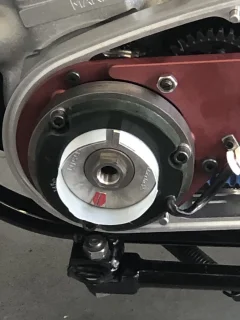robs ss
VIP MEMBER
- Joined
- Aug 16, 2016
- Messages
- 4,242
Oops!!Thats only half of the test Rob… Now you just have to dismantle it to see if it has rubbed !
Redline is at 7,000. I stick to that ‘most’ of the time…
Oops!!Thats only half of the test Rob… Now you just have to dismantle it to see if it has rubbed !
Redline is at 7,000. I stick to that ‘most’ of the time…
Ok, slight leg pulling there.Oops!!
I would point out that in post 211 your rotor shows clear signs of rubbing. Why this is, of course, we have no idea.Interesting - you're describing pretty much where I started at.
When you get your new inner, or repair your old one, I would start with a clearance of 10 thou (3 places as per Norman White et al) and spray painted rotor (to show where any rubbing has occurred).Interesting - you're describing pretty much where I started at.
You're right there.I would point out that in post 211 your rotor shows clear signs of rubbing. Why this is, of course, we have no idea.
For clarity, ‘my route’ wasn’t a suggestion or recommendation for others. It was merely an explanation of my route.When you get your new inner, or repair your old one, I would start with a clearance of 10 thou (3 places as per Norman White et al) and spray painted rotor (to show where any rubbing has occurred).
If there is evidence of rubbing after that then follow Nigel's route and machine the rotor.
My guess is a properly set up stator (well clamped) at 10 thou should be adequate.
Cheers
Yeah...Thats only half of the test Rob… Now you just have to dismantle it to see if it has rubbed !
S’wot I do with the milk carton material…I think that there is one factor that gets forgotten when trying to get rotor clearance. It is critical the the stator is mounted perpendicular to the crankshaft. There may be clearance at the front, but in the same position but behind there may be none, and the reverse on the opposite side of the stator. 10 or so thou can easily be lost if for example the centre stud is not shimmed properly, the stator spacers are not exactly the same height or the inner cover has suffered somehow. Perhaps the best way to determine this (after the crank has been proved true) is to mount the stator on the rotor shim it, then push it home and see if all three studs seat properly before being fastened.

"6 and a bit" = 7kOk, slight leg pulling there.
Real answer with the current engine is: on the track I change up at 7k, which inevitably means sometimes being over that. On the road I tend to change up at 6 and a bit.
With the previous engine (stock crank and cases) I generally wouldn’t go much over 6 and a bit.
Increasing the gap will, in theory, decrease the Amp capacity of the alternator, but in practice, an increase of 20 thou, will be insignificant.I believe the only reason you would require more than 10 thou is if your rotor, when mounted, is out of round.
A dial indicator will tell you this and where material, if any, has to be removed.
Increasing the gap will have a detrimental effect on the capacity of the alternator.
*IF* that seal is all the way in, I want to know how you did it. I've tried everything anyone has said here and always have a major struggle. In the picture, it appears to me that you do not have it inserted all the way - they don't normally show anywhere near that much. Compare it to your other inner primary seal to see if I'm right.Update: After making some enquires about repairing the inner primary case, and scouring the web to find a secondhand one (only one on the market, and it didn’t look great being from an accident damaged bike), I decided to buy new from AN.
The part arrived yesterday and I have to say, I’m really pleased with the quality of it. I’ve completed a test fit and everything is looking great - including stator alignment, which will need a little fettling but not much. I even managed to install the felt seal (see photo). wasn’t too bad!
Hopefully I’ll get some time tomorrow to finish the primary, then it’s on to electrics and backfiring issues.
Then checking everything else over… (trying not to think about what else could be wrong!)
View attachment 104019
Good choice going new, you have removed a ton of variables that cudda bitten you in the arse !Update: After making some enquires about repairing the inner primary case, and scouring the web to find a secondhand one (only one on the market, and it didn’t look great being from an accident damaged bike), I decided to buy new from AN.
The part arrived yesterday and I have to say, I’m really pleased with the quality of it. I’ve completed a test fit and everything is looking great - including stator alignment, which will need a little fettling but not much. I even managed to install the felt seal (see photo). wasn’t too bad!
Hopefully I’ll get some time tomorrow to finish the primary, then it’s on to electrics and backfiring issues.
Then checking everything else over… (trying not to think about what else could be wrong!)
View attachment 104019
Yes, it came with plates spot welded & felt seal in a bag.So AN sells the inner primary with the round plates in place sans seal?
We are very lucky to have such a plentiful spares supply for our bikesYes, it came with plates spot welded & felt seal in a bag.
